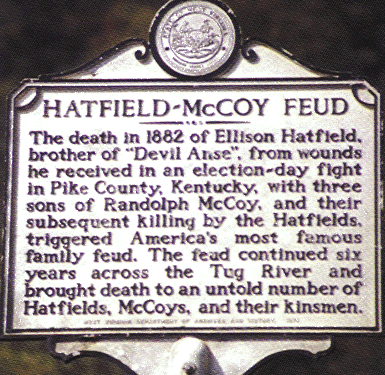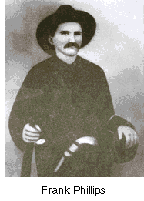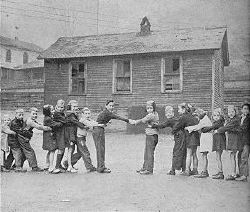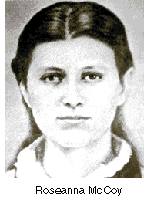
"Ranel" McCoy was convinced that Floyd Hatfield,a cousin of "Devil Anse" who lived on Kentuckey side, stole some of his hogs. Ranel filed a complaint with the justice of the peace which led to a trial. Attempting to ensure an impartial trial, jury of six Hatfields and six McCoys was selected. William Staton, newphew of Ranel McCoy, swore he saw Floyd Hatfield mark the pig's ear himself, so it could not be Ranel's hog. One of the McCoy jurors, Selkirk McCoy, a cousin of Ranel McCoy, voted for acquittal. Floyd Hatfield was acquitted. From then on , Selkirk was known as a traitor. There was no neutral ground between the families. "You are for us or against us," was the patriarchs' cry. "You should support your family and clan." It was this switching of sides that may have created the animosity. ********************************************************************************

In American history and folklore the Hatfields and the McCoys symbolize the backwardness and violence most Americans associate with Appalachian mountain culture. Yet an accurate retelling of this famous instance of family conflict reveals a more complex story - - a story involving competition over rich timer resources and the desire of eastern corporations and state government to foster economic development in the region. The feud was more a foreshadowing of the era of the bloody coal mine wars than it was the final gasp of traditional mountain culture.
Although the historical record is silent on the specific origins of the trouble, it seems to have been related to the market for timber. In the period following the Civil War, America was industrializing at a rapid rate and the high quality hardwoods of the Southern Appalachians were in great demand. In this brief period before large timber corporations were operating in the Tug Valley, local farmers cut and marketed timber. In this endeavor the branch of the Hatfield family headed by William Anderson "Devil Anse" Hatfield had been more successful than any other family in the Tug Valley. Not only were the Hatfields financially successful, they liked to brag about it, thus causing resentment among their neighbors. Randolph McCoy and his family were especially irritated because their own efforts to profit from the timber market had ended in disaster.

Whatever the specific grievances, it is significant that the McCoys attempted to resolve them through the legal system, not with guns and violence as Appalachian stereotypes would suggest. When the court ruled against Randolph McCoy he accepted the verdict but bad feelings festered over the next four years, especially when Devil Anse's son, Johnse, romanced and impregnated but did not marry Randolph McCoy's daughter Roseanna. The peak of hostilities came when three of Roseanna's brothers attacked and killed Ellison Hatfield on election day in 1882. Because the Tug Fork of the Big Sandy River is the boundary between Kentucky and West Virginia and and jurisdiction was unclear, the legal system, for the first time in the feud, broke down. Devil Anse retaliated for the killing of his brother by executing, without trial, the three sons of Randolph McCoy near present day Matewan, West Virginia.
For five years after this shocking incident, things were quiet in the Tug Valley. No newspaper anywhere reported the feud and most residents fervently wished to forget about it. But developments outside the Tug Valley mandated otherwise. The Norfolk and Western Railroad Company announced plans to build a line linking Virginia with the Ohio River to run right through the Tug Valley. This would allow the large scale exploitation of the high quality coal seams known to exist in the region. The Tug Valley was about to become the focus of the economic modernization and development which had bypassed it for so long; there were huge profits to be made in land, timber, and coal.
. In this new political and economic climate, the Hatfield-McCoy feud was revived by a Pikeville lawyer named Perry Cline. Cline was a distant cousin of Randolph McCoy who had grown up in the Tug Valley, a neighbor of Devil Anse Hatfield. As a young man he had fought a protracted legal battle with Devil Anse over five thousand acres of land along Grapevine Creek, West Virginia. In and out of court settlement Cline had lost the five thousand acres to Devil Anse, land that was now skyrocketing in value. In 1887 Cline used his influence with the leading citizens of Pikeville and the Governor of Kentucky to have the five year old murder indictments against the Hatfields reissued and to have an extradition process started to bring them to trial in Kentucky. Not satisfied, however, with the slowness of the legal process, Cline recruited "Bad" Frank Phillips who organized a posse, crossed the Tug Fork into West Virginia and captured nine Hatfield supporters. This entailed several quasi-military skirmishes along Grapevine Creek and an attempt by the Hatfields to eliminate Randolph McCoy on January 1, 1888. This action resulted in the death of two of Randolph McCoy's children and the destruction of their home on Blackberry Fork, Kentucky, by fire.

This was no longer family violence but warfare between Kentucky and West Virginia. The Governor of West Virginia, E. Willis Wilson, accused Kentucky of violating the extradition process and appealed the matter to the Supreme Court of the United States., In May of 1889, the Supreme Court decided against West Virginia; the nine Hatfields would be tried in Pikeville. Although this ruling intensified the efforts of many private detectives to hunt down Devil Anse, the Hatfield leader was never jailed or tried. Wisely, he retreated. Selling the Grapevine Creek lands he moved his family away from the valley to Main Island Creek, near Sarah Ann, West Virginia where a life size statue marking his grave can now be seen. By 1892. the railroad through the Tug Valley was completed and coal began to be shipped out. The towns of Williamson and Matewan sprang up along the West Virginia bank of the Tug Fork. The feud was over. (It had lasted 12 years and cost 12 lives.) But the violence that marked the beginning of economic modernization was to continue and even intensify as mountain farmers became coal miners who clashed repeatedly with owners in a conflict which culminated in the bloody coal mine wars of the 1920s.

Hatfield Children {LEFT} and McCoy Children {RIGHT} Playing Tug- of -War at the Matewan School. ********************************************************************************
Hatfield McCoy Feud Timeline The Hatfield-McCoy feud ran off and on for nearly 30 years. Here, against the backdrop of other events in American history, is a chronology of the feud's main events.
--------------------------------------------------------------------------------1863 Devil Anse Hatfield forms guerrilla band. Raids and thefts follow between McCoy's and Hatfields. West Virginia statehood.
President Lincoln issues Emancipation Proclamation (Jan 1). 1864 General Sherman marches through Georgia, taking Atlanta (Sept 1) and Savannah (Dec 22).
1865 First death in feud -- Asa Harmon McCoy. No prosecution. Civil War ends in May. President Lincoln shot by John Wilkes Booth (Apr 4). Thirteenth Amendment, abolishing slavery takes effect (Dec 18).
1866 World Record in mile run is 4:29.
1867 Alaska is bought by U.S. from Russia for $7.2 million.
1868 Ulysses Simpson Grant is nominated for president.
1869 Women's suffrage law is passed in Territory of Wyoming (Dec 10).
1870 U.S. population reaches 38.5 million
1871 Great fire destroys Chicago (Oct 8-11).
1872 Amnesty Act restores civil rights to citizens of the South (May 22), except for 500 Confederate leaders.
1873 First U.S. postal card is issued (May 1).
1874 Herbert Clark Hoover, 31st president-to-be, was born (Aug 10).
1875 The Kentucky Derby is held at Churchill Downs Louisville Ky., for the first time (May 17).
1876 "Tom Sawyer" by Mark Twain is published.
1877 Ulysses Simpson Grant is elected president.
1878 Randolph McCoy accuses Floyd Hatfield of stealing his pig. Bill Staton's testimony in court later wins for Floyd Hatfield. The first commercial telephone exchange opens in New Haven, Conn., (Jan 28).
1879 F.W. Woolworth opens his first five-and-ten store (Feb 22).
1880 Bill Staton murdered by Paris and Sam McCoy in June. Sam McCoy tried in September for Staton death; acquitted. Roseanna McCoy and Johnse Hatfield meet. She leaves to live with him at Hatfield cabin.
1881 Roseanna returns home, then moves to aunt's cabin where Johnse is captured by McCoy boys. Roseanna's ride to Devil Anse's saves Johnse's life. Pregnant Roseanna returns to Ole Ran'l's home, catches measles, miscarries baby, then moves to Pikeville. Johnse marries Nancy McCoy on May 14.
1882 Ellison Hatfield fatally wounded by Bud, Tolbert and Pharmer McCoy on August 9. After Hatfield dies, the trio is tied to bushes and executed. Jeff McCoy killed on banks of the Tug.
1883 The Brooklyn Bridge opens (May 24).
1884 Harry S. Truman 33rd president-to-be, was born (May 8).
1885 Grover Cleveland elected president.
1886 Geronimo, Apache Indian, finally surrenders (Sept 4).
1887 Kentucky governor appoints Frank Phillips to capture McCoy boys' murderers.
1888 New Year's Day raid on Ole Ran'l McCoy's cabin leaves Alifair and Calvin dead, home burned to ground. Roseanna McCoy, less than 30 years old, dies in Pikeville Great blizzard in eastern U.S. 400 deaths (Mar 11-14).
1889 Trial of Hatfield clan in McCoy murders begins. T.C. Crawford publishes "An American Vendetta." Johnstown, Pa., flood 2,200 lives lost (May 31).
1890 Ellison Mounts executed for Alifair McCoy's murder. (Feb 18). Ellis Island opens (Dec 31).
1891 Feud ends. (1895: Mingo County W.Va. formed from Logan Co.; Matewan also founded. ********************************************************************************

" Devil Anse" Hatfield ********************************************************************************




Come and listen to my story Of fair Rosanna McCoy, She loved young Jonse Hatfield Old Devil Anse's boy.
But the McCoys and Hatfields Had long engaged in strife, And never the son of a Hatfield should take a McCoy to wife.
But when they met each other, On Blackberry Creek, they say, She was riding behind her brother, When Jonse rode along that way.
"Who is that handsome fellow?" She asked young Tolbert McCoy. She he, "Turn your head, sister, That's Devil Anse's boy."
But someway they met each other, And it grieved the Hatfields sore; While, Randall, the young girl's father, Turned his daughter from the door.
It was down at old Aunt Betty's They were courting one night, they say, When down Rosanna's brothers And took young Jonse away.
And Rosanna's heart was heavy, For she hoped to be his wife, And well she knew her brothers Would take his precious life.
Straight to the Hatfields' stronghold, She rode, so fearless and brave, To tell them that Jonse was in danger And beg them his lifeto save.
And the Hatfields rode in a body And saved young Jonse's life; But never, they said, a Hatfield should take a McCoy to wife.
But the feud is long forgotten And time has healed the sting, As Little Bud and Melissy This song of their kinsmen sing.
No longer it is forbidden That a fair-haired young McCoy Shall love her dark-eyed neighbor Or marry a Hatfield boy.
And the people still remember, Though she never became his bride, The love of those two young people, And Rosanna's midnight ride.

